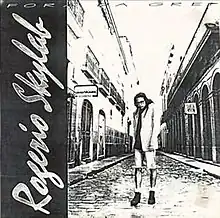Fora da Grei
Fora da Grei (Portuguese for Outside the Flock) is the debut album by the Brazilian musician Rogério Skylab; self-released in 1992, it is the musician's only album to come out in vinyl format[1] as well as his only main studio release not to be part of a series. Its title is intended to be a pun on the Portuguese-language term "fora da lei" ("outlaw").
| Fora da Grei | ||||
|---|---|---|---|---|
 | ||||
| Studio album by | ||||
| Released | 1992 | |||
| Recorded | 1992 | |||
| Studio | Estúdio Clave de Fá | |||
| Genre | ||||
| Length | 36:49 | |||
| Label | Self-released | |||
| Producer | João Ataíde | |||
| Rogério Skylab chronology | ||||
| ||||
The track "Naquela Noite" would be re-recorded for his next release, Skylab. "Blues do Para-Choque" was re-recorded for Skylab III, "Casas da Banha" for Skylab VIII and "Palavras São Voláteis" for Melancolia e Carnaval.
The album can be downloaded for free on Skylab's official website.[2]
Background
Prior to the album's release, Rogério Skylab (stage name of Rogério Tolomei Teixeira), a graduate in literature and philosophy from the Federal University of Rio de Janeiro, worked as a bank officer at a Banco do Brasil agency;[3] even though he had performed with a short-lived punk rock group, Setembro Negro, during the mid- to late 1980s,[4] Skylab once claimed that he originally never thought about pursuing a career as a musician, instead wanting to dedicate himself to literature or becoming a teacher.[5]
In 1991, "just for fun", Skylab travelled to Juiz de Fora, Minas Gerais, to partake at a well-known music festival which used to be held there.[6] His entry, "Samba do Skylab" (from which he subsequently took his stage name[4]), won the festival's first-place cash prize. He then used the money to finance the production of Fora da Grei. Despite the album's "dismal production", since "at the time independent records in Brazil were like aliens" in Skylab's words,[1] Fora da Grei was critically acclaimed to the point of even being considered one of the best of the year by the Jornal do Brasil,[7] and the musician was invited many times by Jô Soares to promote it on his late-night talk shows, Jô Soares Onze e Meia and later the Programa do Jô,[8] what would effectively launch his musical career. However, Skylab wouldn't work on a follow-up until 1999, when he released his first of ten eponymous albums.
Track listing
All tracks are written by Rogério Skylab.
| No. | Title | English title | Length |
|---|---|---|---|
| 1. | "Fora da Grei" | Outside the Flock | 3:06 |
| 2. | "Blues do Para-Choque" | Bumper Blues | 3:30 |
| 3. | "Tucuruí" | 2:10 | |
| 4. | "Palavras São Voláteis" | Words Are Volatile | 4:05 |
| 5. | "Casas da Banha" | Lard Houses | 3:09 |
| 6. | "Essa Voz" | This Voice | 2:02 |
| No. | Title | English title | Length |
|---|---|---|---|
| 7. | "Polka" | 5:16 | |
| 8. | "Minha Vida É uma Estrada" | My Life Is a Road | 7:17 |
| 9. | "Naquela Noite" | In That Night | 3:51 |
| 10. | "Uma Ideia na Mão e um Violão Vagabundo na Cabeça" | An Idea in My Hand and a Crappy Guitar in My Head | 2:57 |
| Total length: | 36:49 | ||
Personnel
- Rogério Skylab – vocals
- Alexandre Guichard – charango, mandolin, ten-string guitar
- Raimundo Nicioli – keyboards
- João Ataíde – bass guitar, production
- Edson Cortes, Don Fla – percussion
- Ayrton Seixas Jr. – cover art
- Adriano Raimundo – photography
- Tita Albuquerque – mixing
- Ricardo Misutani – mastering
- Marcos Petrilo – executive production[1]
References
- Rogério Skylab – Biografia (in Portuguese)
- Rogério Skylab – Fora da Grei
- "Ex-bancário, Matador de Passarinho condena Felipão: 'Falou besteira'" (in Portuguese). November 30, 2012. Retrieved April 17, 2017.
- Entrevista / Skylab (in Portuguese)
- Bate-papo com Rogério Skylab | Bate-papo UOL Archived 2017-01-18 at the Wayback Machine (in Portuguese)
- A história dos Festivais de Rock de Juiz de Fora na década de 1980 através da imprensa da cidade (in Portuguese)
- Tratore - Rogério Skylab (in Portuguese)
- Leonardo Rodrigues (July 15, 2014). "Sempre fui contra a imagem cômica que Jô Soares me deu, diz Rogério Skylab" (in Portuguese). Retrieved April 6, 2017.